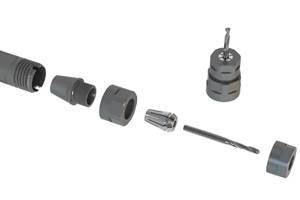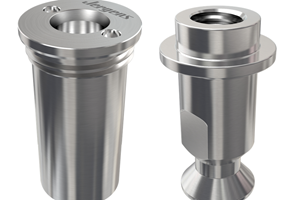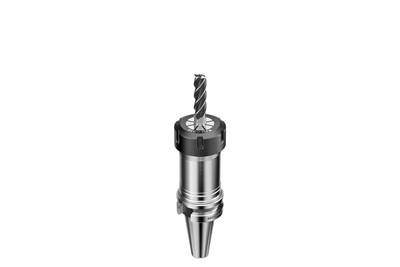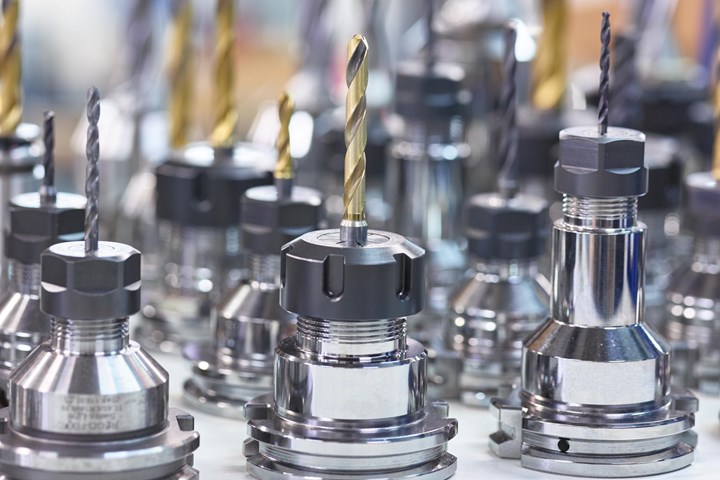
Collets put the grip in toolholding, so it’s important to assemble and maintain them properly. ER collets have features that eliminate a main source of collet damage, but like any piece of equipment, they’re still susceptible to damage when not used properly. Photos provided by REGO-FIX.
Collets, like any other piece of equipment, are not immune to wear and tear or damage. However, proper use, tool assembly and maintenance can minimize these effects. This is important because, according to REGO-FIX marketing specialist Jonathan Harvey, the collet, not the toolholder, plays the bigger role in machining accurate parts. Using damaged collets can result in damaged tools and toolholders, reduced clamping force, excessive runout and bad parts.
ER collets were designed to eliminate a major source of collet damage. An extraction groove on the outer rim receives a lip on the clamping nut so users don’t need to hammer or punch tools out of the collet. But even with this feature, ER collets are still susceptible to damage when not used properly. Harvey says these are the five most common mistakes REGO-FIX sees from users of ER collets, and provides tips on how to avoid them.
1. Insufficient Bore Length
One the most common mistakes shops make in tool setup is failing to use enough of the collet’s bore length and gripping surface. According to Harvey, shops should use at least two-thirds of the collet’s gripping surface. Often, the tool is not inserted deep enough into the collet because operators are trying to extend a cutting tool’s length farther than recommended.
Most ER collets are made of fairly soft steel – about 45 Rockwell Hardness C, Harvey says. When used with cutting tools made from much harder materials, such as carbide, the machining process exerts a tremendous amount of force at the toolholder collet-cavity edge, which is its weakest point.
These forces are almost certain to crack the tool holder, damage the collet, or both. Failing to use the proper shank and bore length also prevents the collet from achieving its proper gripping force, and the resulting tool deformation causes excessive runout and decreased part quality.
To solve this problem, shops should always use the proper tool length and opt for a longer one if necessary. The ER collet system has a substantial cavity behind it, so the collet base can accommodate excess tool length.
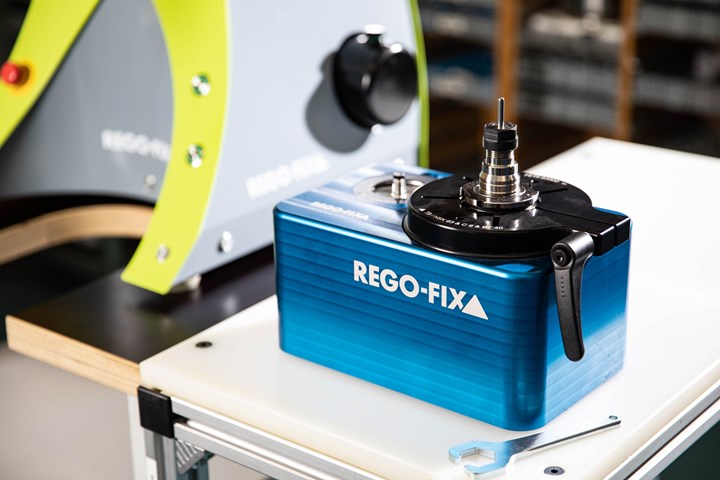
The TORCO-BLOCK serves as both a fixture and torque measuring device for simplifying tool assembly. Users set the diameter of the tool, then tighten the nut with a spanner wrench until the dial reaches the proper torque value.
2. Incorrect Torque Values
In most instances, operators torque their setups to what they “feel” is a good value. While this method might produce the proper torque value in some cases, it often results in over-torqued nuts, which can encourage collet deformation and lead to runout.
To avoid improper torque values, Harvey says shops should use quality torque wrenches and appropriate charts. An alternative solution is the REGO-FIX TORCO-BLOCK, which serves as both a fixture and torque measuring device. Users set the diameter of the tool, then tighten the nut with a spanner wrench until the dial reaches the proper torque value.
The clamping nut itself also plays a role in proper torque. Plain metal ER nuts wear quickly as they’re torqued down, Harvey says. Nuts that are coated with a material such as black oxide are more resilient, but still wear with use.
ER nuts can also be chemically impregnated with materials to make them harder and more durable, such as REGO-FIX’s Hi-Q line of ER collet nuts. This increases lubricity between the surfaces of the collet and nut for improved life span of the system and increased clamping force without wearing.
The company says testing has shown that the lubricity of the Hi-Q nut increases clamping force by 180% over a standard clamping nut. Clamping nuts are interchangeable, so manufacturers experiencing problems resulting from low clamping forces can switch to a high-performance ER nut without investing in an entirely new ER assembly.
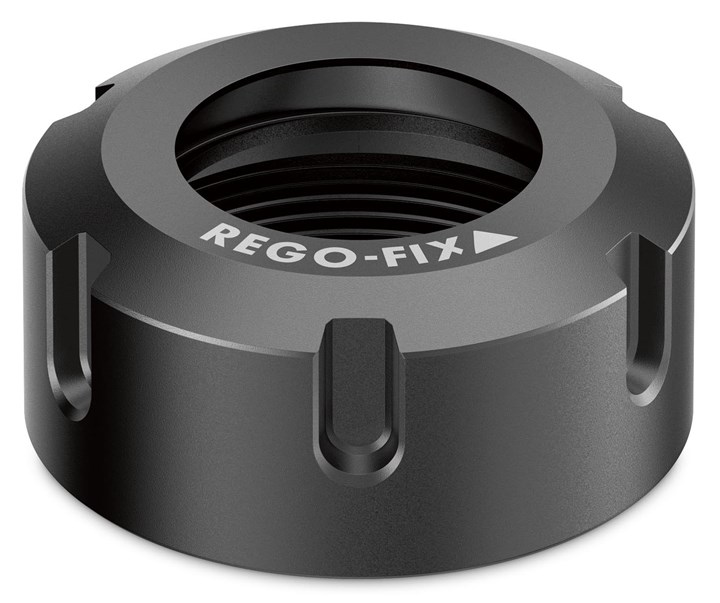
REGO-FIX’s Hi-Q ER clamping nuts are chemically impregnated with materials to improve their life span and increase clamping force without wearing. These clamping nuts can be used with any ER system, enabling users to increase clamping forces without investing in a whole new tooling system.
3. Faulty Assembly of Collet and Clamping Nut
Incorrectly assembling the tool by placing the collet in the holder before the clamping nut is installed can cause runout of up to 0.001 inch, Harvey says. For proper assembly, users should place the collet into the nut, insert the tool, and then screw the nut onto the holder.
Another common mistake operators make is holding the collet incorrectly, causing it to fall off the eccentric ring or lip inside the clamping nut. If the misalignment is not noticed, the ring is pushed over the collet nose’s 30-degree taper, damaging the collet and causing excessive runout.
“Making sure the collet is properly seated within that nut is tantamount to proper assembly,” Harvey says. The REGO-FIX Hi-Q ER nut has a retaining ring profile that snaps the collet in place. When operators hear and feel the snap, they can be confident the assembly is correct.
This video from REGO-FIX demonstrates how to properly assemble an ER collet:
4. Improper Use of Backup Screw
Some holders use a backup screw to assist with adjusting tool length by causing the tool to rest against the screw. “We recommend not using the backup screw,” Harvey says. It can interfere with proper setup if the tool is pushing against the screw during assembly.
During a normal setup, the collet will pull back almost 0.003 inches from hand-tight to full torque value. If the collet cannot pull back, the collet can lose as much as 50% of its clamping force and runout increases, he explains.
This won’t be an issue for everyone — most suppliers have removed backup screws from toolholders. Those whose toolholders do have backup screws can remove the screw completely, or loosen it from the back end after hand tightening it.

Coolant, dirt, chips and other foreign material can make their way into the collet cavity or onto the collet face, which can impact performance. Operators should clean collet cavities with a brass brush and cleaning agent, while compressed air and a thorough wipe down will take care of the collet face.
5. Not Cleaning Collets
With increasing production demands, operators may be tempted to remove one tool, insert another and get back to machining. However, Harvey says one of simplest things shops can do to ensure toolholder performance is to keep its collets clean.
Regularly used collets may collect deposits on their tapered areas. These deposits can be caused by a variety of factors including dirty coolant, dirt in the toolholder and foreign material making its way into the collet cavity. A cleaning agent and brass brush are excellent cleaning tools.
The collet face is also prone to collecting chips. Any foreign matter collecting in the collet slots diminishes its ability to collapse on the tool shank and can cause runout and loss of clamping force. Blowing the components out with compressed air after disassembly followed by thoroughly wiping down and drying the collets will take care of most cleanliness issues. Simply stated: cleanliness is critical.
Related Content
All-Around Mill Improves Productivity and Cost for Valve Job
Adopting a mill with a double-negative rake and pockets compatible with multiple insert geometries enabled Progressive Metal Service to increase feed and lower scrap rates for a valve.
Read MoreGenSwiss Releases Redesigned Toolholding System
Its GenQuick quickchange ER system for Swiss-type CNC machines and precision machining equipment has been updated.
Read MoreIMTS Takeaways From the Modern Machine Shop Editorial Team
The first in-person IMTS in four years left the MMS editorial staff with a lot to digest. Here are a few of our takeaways from the show floor.
Read MoreJergens Pull Studs Enable Quick Changeovers
SP140 and K02 pull studs offer quick-change solutions for vise or gripper jaws, electronic component manufacturing, packaging machines, medical technology and automation.
Read MoreRead Next
What If You Don’t Have a Torque Wrench?
This device ensures that ER collets are torqued to the proper value using any type of wrench.
Read MoreRego-Fix Celebrates 50th Anniversary of the Original ER Collet
In 1972, Rego-Fix developed and manufactured the original ER Collet.
Read More3 Mistakes That Cause CNC Programs to Fail
Despite enhancements to manufacturing technology, there are still issues today that can cause programs to fail. These failures can cause lost time, scrapped parts, damaged machines and even injured operators.
Read More









.png;maxWidth=300;quality=90)















